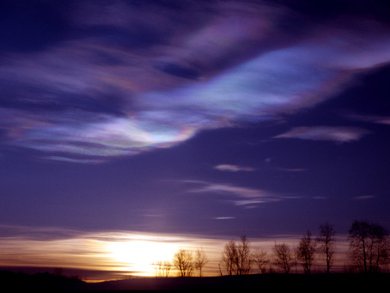An international network of 30 ozone sounding stations in the Arctic and Subarctic that is coordinated by the Alfred Wegener Institute reports an ozone depletion above the Arctic which is far beyond that recorded for any other spring, over the time when ozone has been measured by modern instrumentation.
Ozone-depleted air masses extended from the north pole to southern Scandinavia leading to higher than normal levels of UV radiation during sunny days in southern Finland. These air masses will move east over the next few days, covering parts of Russia and perhaps extend as far south as the Chinese/Russian border. Such excursions of ozone-depleted air may also occur over Central Europe and could reach as far south as the Mediterranean. The researchers expect UV intensities during short episodes which will remain in the range of typical exposure at the height of summer.
The air masses with very low ozone concentrations will eventually disperse, as the sun warms the stratosphere and the winds change, as happens every year in spring. This will lead to somewhat lower ozone in spring and early summer this year, as the low ozone from the Arctic mixes with other stratospheric air throughout the northern hemisphere. Due to the large dilution of the ozone depleted air masses in the background air, the effect will be small.
This year’s Arctic ozone depletion is caused by industrial chlorofluorocarbons (CFCs) and related compounds. Ozone loss was particularly large this winter due to unusually low temperature, which results in the presence of clouds in the polar stratosphere. Reactions on the surface of these clouds transform chlorine containing breakdown products of CFCs into compounds that aggressively remove ozone. Even though the Montreal Protocol has successfully banned the production of CFCs and related compounds, chlorine levels in the Arctic stratosphere are only about 5% below the prior peak level, due to the long atmospheric lifetime of CFCs (50 to 100 years). The Arctic ozone layer will remain vulnerable to depletion for the next several decades, particularly following unusually cold winters.
In contrast, temperatures within the Antarctic stratosphere are cold enough, each winter, to lead to widespread occurrence of stratospheric clouds that are part of the chain of events that causes the Antarctic ozone hole that occurs each spring.
The stratosphere has been observed to cool, following the rise of greenhouse gases (GHGs), because heat that would otherwise reach the stratosphere is trapped below, warming the surface. The situation for the Polar Stratosphere is more complicated because of dynamical heating by waves generated in frontal systems. For several years scientists have noted that the coldest winters in the Arctic stratosphere are getting colder, a development that enhances the ozone-destroying efficiency of the remaining CFCs and could be linked to rising levels of GHGs.
Image: Polar stratospheric clouds in the Arctic. (C) Ross J. Salawitch, University of Maryland.
- Alfred Wegener Institute, Bremerhaven, Germany




